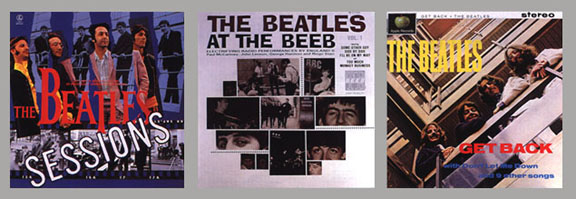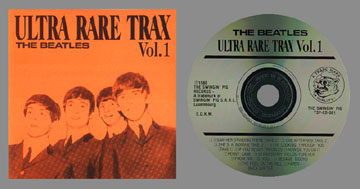





| The FIRST Beatles Bootleg CDs - 1987 |
 |
 |
| Debuting in late 1987, these are the FIRST Beatles bootlegs to ever appear on compact disc (almost exactly twenty years earlier, in November 1967, the first bootleg album with Beatle cuts appeared on the market - titled Best of '67). Made by a northwest U.S.A. collector, all three were pressed in a limited edition of 500 and issued at the same time. They were originally sold only in sets for an outrageous retail price of $300 to $400. A few months later they were being offered separately for $100.00 ea. Due to their premium price, they moved slowly but eventually sold out in less than a year.
In 1987 there were only a few pressing plants in the world pressing CDs. Because of this and the expensive/complicated process of making glass masters, and the fact that the plants were near capacity due to the rising popularity of the compact disc, many collectors thought at the time that it would be many years before bootleg pressings would appear on CD. Unlike vinyl pressing plants that numbered in the thousands worldwide, of which many would manufacture product "no questions asked," the plants pressing CDs were very legitimate with major record company accounts and would likely have turned anyone in that attempting to order illegal discs. As the story goes, the bootlegger edited together three master tapes using vinyl sources for the discs, and taking a chance, sent them to an east coast U.S.A. pressing plant. Enclosed with the tapes was a letter on stationary from the university that the bootlegger attended stating the university had been authorized by Capitol Records and EMI to press 1500 Beatles CDs for a special student promotion they were having. A few weeks later the CDs arrived from the pressing plant, covers were made, and the rest is history. By the time all of the discs were sold via retail and wholesale, a profit of nearly $76,000 was made, which the bootlegger used to pay for his four-year college tuition... |

|
 |
| Silver foil sticker placed on the front of the jewel cases. Many books incorrectly list the release date of these CDs as 1988. They were pressed in 1987, "to commemorate" the 25th anniversary of the Beatles' first record released in 1962... |
 |
| Ultra Rare Trax Vol. 1 (shown) and Vol. II, issued on the Swingin' Pig label in 1988, were the first widely distributed bootleg CDs. Their stunning sound quality and content set a reference standard that just about every CD issued since has been measured against. The following section from the 1995 book, Black Market Beatles, tells the story well: |
|
The popularity of compact discs had an interesting effect on collectors of rare tape recordings. It brought hundreds of hitherto-unreleased tapes out of the closet and into the black market underground. A rebirth of Beatles bootlegs occurred in late 1988 with the appearance of Ultra Rare Trax Volume I & II (The Swingin' Pig, TSP-CD-001, TSP-CD-002, CD). An underground consortium of collectors and entrepreneurs using the name The Swingin' Pig recognized the profitability of their rare tapes, containing superb-quality Beatles outtakes and alternate takes pilfered from the vaults of EMI Records. They pressed them onto a limited run of approximately 3-5,000 compact discs. The first Ultra Rare CDs sent shock-waves throughout the legitimate recording industry. Suddenly there were stereo releases of songs from the first four Beatles albums (which had been released as mono CDs by EMI and Capitol Records). Not only that, but the sound quality was even better than the legitimate compact discs! Ultra Rare Trax. Volumes I & II also featured outtakes and alternate takes of songs such as, "I Saw Her Standing There," "One After 909," "She's A Woman," "I'm Looking Through You," "The Fool On The Hill," "Paperback Writer," "There's A Place," "That Means A Lot," "Day Tripper," "I Am The Walrus," "Norwegian Wood" and many more. It was a stunning collection even at just 30 minutes per disc, filled with mistakes, broken guitar strings, false starts, jokes and jams. Perhaps the musical highlight of the series was the amazing first take of "Can't Buy Me Love." This rejected alternate take features lush background vocal harmonies which were abandoned on the final take. For long-time collectors and fans of the group, listening to alternate versions of familiar songs was like hearing the songs again for the first time. How these recordings came to fall into the hands of bootleggers still remains shrouded in mystery. The Ultra Rare bootlegs appear to have been made directly from tapes dubbed off the master tapes. Since the master tapes of these songs are still locked "safely" in the vault, it is clear that someone on the "inside" had to have assisted in their procurement. Paul McCartney suggested in a 1990 TV interview that engineers or even studio musicians working at the studio could have been involved. There was an attempted robbery in the late eighties at EMI/Abbey Road; however, it was (in McCartney's words) "so disorganized at EMI, the robbers couldn't find anything." According to noted Beatles' historian, Allen J. Wiener, EMI had, in the past, dismissed a couple of its employees over the years who had access to the unreleased Beatles' master tapes. Thus, the probability that the tape copying was done on the inside cannot be ruled out. Another explanation for the escape of historical Beatles recordings is that the tape copies could have been made by "runners" for author Mark Lewisohn, who at the time was cataloging EMI's Beatles tapes for his book, The Complete Beatles Recording Sessions (Harmony, 1988). As the rumor unfolds, unbeknownst to Lewisohn, the "runners" (assistants given the job of relaying the tapes to and from the vaults so Lewisohn could listen to the tapes) would not immediately return the tapes Lewisohn had finished, to the vaults. Instead, they could have kept back tapes and digitally copied them on portable equipment as time allowed, before returning them to the shelf. It is important to note that this explanation is merely a theory based upon reports from the very people who are involved in the underground music industry, and thus, lack credibility. When asked about this theory in a 1992 interview with historian Allen Wiener, Lewisohn conceded he hadn't thought of this explanation, but did not deny that it was a possibility. As Lewisohn's book preceded the release of Ultra Rare Trax by a mere few months, it appears obvious that bootleggers used the book's release as both a smoke-screen and a boost for marketing their CDs. Their ploy also caused some to wrongly accuse Mark Lewisohn of the misdeed. According to EMI employee Mike Heatley, in a November 1988 interview with ICE, The Monthly CD Newsletter, he was puzzled as to how The Beatles' tapes had escaped. Said Heatley:
The sound quality on the Ultra Rare Trax series was phenomenal. Many people are of the opinion that the one-inch masters were used and thus, it had to be an "inside job." Heatley told ICE, though, "I would dispute that completely ... they could've been done on quarter-inch tape many years ago." He also denied stories that CD test pressings sent to the Beatles might have been a source or that Mark Lewisohn had anything to do with the tapes leaking out. Still others believe that these studio outtakes actually slipped out at two distinct times in the 1980s. The first leak purportedly occurred during the studio compilation project for EMI's aborted Beatles album, Sessions. A limited amount of tape dubs were made of certain unreleased Beatles songs reviewed for the project. A person or persons later sold the copies through a middleman, which then made their way into bootlegger's bands. A second leak is also said to have occurred around 1987, during the production of a radio special on the Beatles. Again, tape copies were made and distributed through an intermediary to both The Swingin' Pig and Yellow Dog Records. The price was said to be in the $20,000 range for about six hours of tape. Unconfirmed rumors tell a story that Yellow Dog had not intended to release its tapes, as part of their "good faith" agreement with the previous tape owner. However, once Swingin' Pig broached the market with its "Ultra Rare Trax" series, it effectively forced the hand of Yellow Dog to follow suit with its heralded "Unsurpassed Masters" series. Although the original tapes are said to be back at EMI, the damage had already been done. Many hours of rare music were ultimately released without the permission of either the group or its record label. One fact is certain -- the trail of the greatest musical theft in history is now as cold as the one seeking John F. Kennedy's other assassins. In February of 1989, Capitol Records, U.S. distributors of the Beatles catalog, sent a stern "Cease and Desist" letter to retailers suspected of selling these illegal CD recordings. Capitol threatened legal action against retailers who continued to sell Ultra Rare Trax and similar recordings. The letter had little deterent impact or effect. Following the release and importation into America of Ultra Rare Trax. Volumes I & 2, Volumes 3 through 6 were pressed in the vinyl configuration -- purportedly by an underground competitor using The Swingin' Pig name. The Swingin' Pig CD configurations soon followed, but proved a disappointment compared with the first two volumes. Another Euro-bootlegger knocked off some of the same recordings under the Back Trax series name, producing his discs in Korea. American and Japanese record retailers sold these recordings as fast as they could stock them. In light of heightened media attention surrounding these historic illegal Beatles' recordings, public hunger for these and similar recordings increased dramatically. The result is that EMI Records UK and the Beatles' Apple Ltd. are now planning a six-CD set for commercial release in 1995 that will contain previously unissued material from the vaults (which became The Beatles Anthology...).
Excerpts from the book Black Market Beatles, ©1995 Jim Berkenstadt and Scott Belmer. This 240 page softbound book is a must for any collector or fan of underground recordings. (original price U.S. $14.95, Collectors Guide Publishing) |
1997 marked the tenth anniversary of the bootleg CD, and as we enter the new millinium nearly 1000 Bootleg Beatles CDs (including solo releases and variations) will have been released on the market. The trend lately, however, has almost turned entirely to CD-R pressings, adding hundreds or perhaps thousands more home-made titles to the marketplace. |


